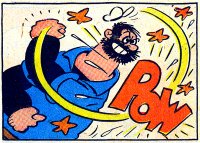
Brutus, as drawn by Bud Sagendorf, 1967 |
We have talked about the history of Popeye's arch-foe Bluto
quite a bit [click here] - so how
come he, after being introduced to the comic strip in 1932, was used
exclusively in the Fleischer and Paramount
cartoons but didn't return to either the comics nor cartoons by other
studios until much much later (despite the many recurring bearded villains
Popeye had to fight)?
I am
speculating but is it possible E.C. Segar, Bluto’s creator, felt he was
needed only as a onetime villain in the comic strip.
Popeye had a fierce battle with the bearded brute in 1932, then
moved on to other opponents. Tom
Sims, who was Segar’s successor on the scripts, apparently felt the same
way until Ralph Stein took over the writing chores.
On March 27, 1957 Stein wrote Bluto back into the daily strip and
he became Popeye’s recurring nemesis chiefly as a treasure seeking,
machine gun carrying, pirate. It
is possible Bluto’s popularity in the theatrical films, which became a
smashing success on television, may have played a part in Stein’s
decision to write him back into the daily strip.
|
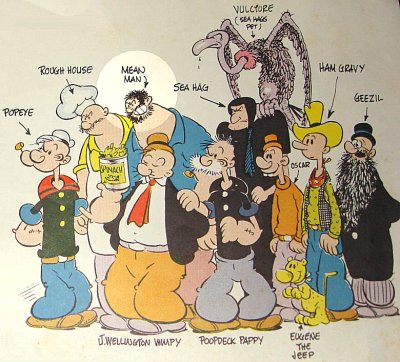
The Popeye-family, circa 1950's,
featuring "Mean Man" |
If I'm correct, the first
time a Bluto-style villain was introduced back into the Popeye-comic
books
was in 1957, who I believe eventually emerged to being Sonny Boy. So what
can you tell us about this character's creation and his origin story?
Sonny Boy was created by Bud
Sagendorf who was Segar’s assistant.
He was a muscular bearded brute, wearing a captain’ hat, who was
the son of Popeye’s most hated enemy, The Sea Hag. His origin involved
Paramount Pictures, who produced the Popeye theatrical films, claim they
owned the name Bluto. Actually the bearded brute first appeared in the
comic strip in 1932 distributed by King Features Syndicate. The character
was taken from the strip and used in the Betty Boop cartoon
Popeye the
Sailor (1933). Sagendorf stated, thanks to the success of the
theatrical cartoons on television, Bluto was becoming a popular character
but he could not be re-introduced in print with his original name.
I discovered something was amiss
when I ran across a “Popeye Family” drawing where Sagendorf used the
name “Mean Man".
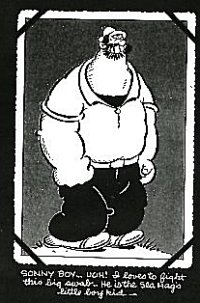
Comic Album
No. 7 (1959) |
Sonny Boy had no origin story and he just
appeared in Popeye #43 (1958) alongside his mother, The Sea Hag. The old
witch had various relatives featured in particular storylines and not
referred to again, but Sonny Boy had a longer shelf life. In Comic Album
No. 7 (1959) Popeye described him : “Ugh! I loves to fight this big
swab. He is the Sea Hag’s
Little Boy Kid.” What
other characters shared Sonny Boy’s character design? Why didn’t the
character design for each vary?
|
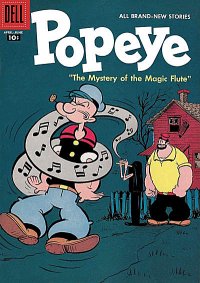
Popeye #40 (The Mystery of the Magic
Flute,1957) |
 |
|
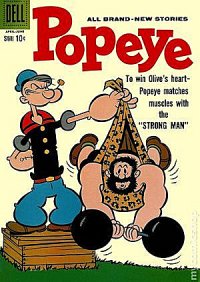
Popeye # 48 (Strong Man, 1959) |
The
first character to appear in the comic book series sharing Sonny Boy’s
looks was known as “The Big Guy That Hates Popeye” who debuted in Popeye
#40 (The Mystery of the Magic Flute,1957). He appeared on this
issue’s cover wearing a red sailor’s hat. The hat was probably added to
make the public believe this was the more familiar Bluto.
He makes little more than a cameo appearance in the interior. Popeye #41
(Spinach Soap, 1957) billed him as Olive’s new
“boyfriend” while in Popeye #42 (On Trap Island, 1957) he went unnamed
while plotting with The Sea Hag. As
previously mentioned Sonny Boy bowed in issue #43 (Mind Over Muscles,
1958). Bud Sagendorf used characters who shared Sonny Boy’s visual
design in subsequent issues. For
example in Popeye #47 (Popeye’s Cafe, 1959) he is the new owner of
“Mike’s Place”, Popeye #48 (Strong Man, 1959) presents him as “The
Strong Man” and Popeye #49 (Trillionaire Lady, 1959), dressed him up as
“The Duke of Crust”. I
can only assume Sagendorf did not vary each of these brute’s character
designs because the public expected Popeye to be seen battling muscular
bearded bullies. Whatever his
name, children reading the comic books at this time probably thought he
was Bluto. When Al Brodax started producing Popeye
cartoons for television in 1960, his bearded villain was called Brutus.
Now what can you tell us about the creation of that character, and why the
name Brutus? I would like to quote Walter M. Brasch from the book Cartoon Monickers
(Bowling Green University Popular Press, 1983); “Bluto, half of one of
the most violent combinations in animation history, fought with Popeye in
comic strips, then in film during the 1930’s and 1940’s, only to lose
his name in 1960 when King Features Syndicate bought all rights and
decided to create additional Popeye cartoons.
A persistent belief in the industry suggests that Bluto’s name
was changed to Brutus because of its supposed similarity to Mickey
Mouse’s dog Pluto. However,
since Walt Disney didn’t complain three decades earlier, it’s highly
unlikely that the Disney organization would now complain.
After all, even the most suspicious could hardly find a similarity
between a lovable, klutzy dog who barks, and a greedy muscle-bound hulk
who, if network standards had permitted, would have sworn blue streaks six
minutes straight. Al Brodax,
head of the motion picture and film division for the syndicate’s legal
counsel suggested that Bluto’s name, apparently the only name in the
series under copyright to the Fleischers, who had first animated the
Popeye characters and created the character Bluto, be changed to prevent
possible legal problems. It’s
possible that in legal discussions, the name similarity to Pluto did come
up, and may have been considered by the counsel, but it was not a
significant reason for the change. Brodax
says that the name Brutus was based upon the name of Julius Caesar’s
principal assassin. It’s
also probable that Brutus gave immediate connotations of brutal, a
characteristic well-entrenched in the personality.” Brasch pretty much
covers the reasons for the creation of Brutus for the television cartoons
although, as research bears out, Bluto first appeared in the comic strip
which was syndicated by King Features.
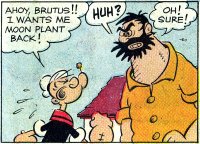
Popeye #64 (Moon Plant, 1962) |
When and how was Brutus introduced into the
Popeye comicbooks?
Brutus
first appeared in Popeye #64 (1962) in a story called Moon Plant.
However, in this same issue, an unidentified bearded brute,
resembling Sonny Boy, was seen in the story Rowboat War. Popeye
#66
(1962) was a giant-sized issue and Sonny Boy returned to help his mother,
The Sea Hag, in Witch Ship. The
name Brutus seemed to stick with his appearance in Ghosk Mountain
from Popeye #67 (1963), which was another giant-sized issue. Was the transition from Bluto to Sonny Boy
and finally Brutus a smooth one?
|
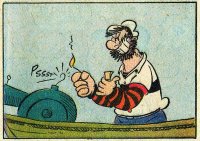
Unnamed bearded villain, Popeye #64 (Rowboat
War, 1962) |
 |
|
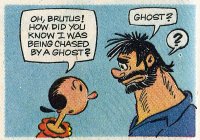
Popeye #67 (Ghosk Mountain, 1963) |
Oh
god no! Popeye historians are
always being asked the infamous question, “Why was Bluto’s name
changed to Brutus” or “Is it Bluto or Brutus?” Over the years, similar
looking Popeye-villains appeared in various media, including daily and
Sunday comic strips, animated cartoons, and toys and other
products, but under a variety of different names. Could you elaborate on
that?
The transition from Bluto to
Brutus in the animated films was smooth.
It was Bluto who plagued Popeye in the theatrical films produced by
both the Fleischer and Famous Studios.
In the television cartoons, animated by five different studios for King Features Syndicate, it was Brutus.
Writer
Ralph Stein’s first Popeye daily strip (illustrated by Bill Zaboly) was
dated December 6, 1954. As previously mentioned, he reunited the
spinach-eating sailor with Bluto on March 27, 1957. The pair would
continue to meet, with Stein at the helm, until May of 1959. Of course,
while all this was happening in the daily strip, unidentified bearded
brutes or Sonny Boy bothered Popeye in the comic books by Bud Sagendorf.
I would suspect Stein was so far ahead in his work load it would
have been virtually impossible for King Features Syndicate
to remove the
name, Bluto, from the completed dailies. Another theory is Popeye’s
visibility was far greater in the comic books thus the Bluto issue was
more of a concern in this medium rather than the newspaper page.
The Evolution of Popeye's Bearded Foe in the Dailies:
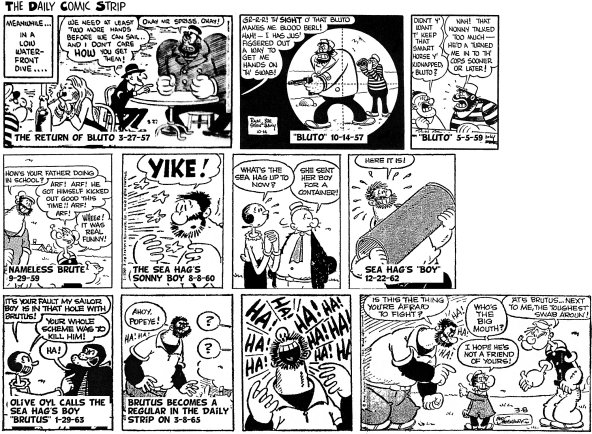
Beginning on August 10, 1959 Bud
Sagendorf was now writing and drawing the daily strip. On September 29,
1959 an unidentified bearded brute encountered Popeye.
To the casual reader, or a frequent viewer of Popeye’s cartoons
on television, in their minds this was Bluto. In the daily dated
August 5, 1960 The Sea Hag instructed her “Sonny Boy”, with a
bulbous dented nose, to beat up Popeye. On November 12, 1962 a daily story
called, The Door to Nowhere or Knock! Knock! or Who’s
There began. The Sea Hag,
with the help of her son, planned on launching Popeye into space.
In the daily dated December 22, 1962 Wimpy refers to the witch’s
helper as her “boy”. However,
on January 29, 1963, Olive says to The Sea Hag, “It’s your fault my
sailor boy is in that hole with Brutus!”
In this story The Sea Hag’s bearded “Sonny Boy” was
christened, Brutus. By the time he returned to the daily strip on March 8,
1965 he was no longer related to The Sea Hag. The long gap between
appearances was possibly Sagendorf‘s way of having Brutus remerge
without reader’s associating him with Sonny Boy.
Bud Sagendorf’s first Sunday
page was published on September 13, 1959 and nameless bearded brutes would
pop up literally to supply the PUNCH line. Beginning in September and
through October of 1962 Sagendorf produced a Sunday story arc featuring
The Sea Hag and her son. In the Sunday dated September 9, 1962 The Sea Hag
was in town. Popeye informed
Olive, “The ol’ witch is lookin’ fer a wife fer her son!”
The September 16, 1962 Sunday saw Popeye beating the witch’s
“baby” when the brute forced himself on Olive Oyl!
The beaten up suitor said to his witchy “mother”, “You and
your big mouth! Ugh! Why didn’t you include that pop-eyed sailor in your
motherly advice?” On Sunday,
September 23, 1962 Olive
explained to Popeye, “The Sea Hag’s son can’t help it if his mother
is a real live witch!” The Sunday dated September 30, 1962 Olive said
“It’s wonderful having two men in love with me!”
She makes a date with Popeye, and in one panel, quite happily
says on the phone, “That’s right Brutus... Sandy Point at one! We’ll
have fun!” Popeye and Brutus
arrive at Sandy Point battling each other furiously!
I believe this is the first Sunday to use the name, Brutus. The
following Sunday published on October 7, 1962, The Sea Hag can’t
stand the idea her “beautiful son” is in love with Olive Oyl! The
Sunday page dated October 14, 1962 had Popeye shouting, “There’s Olive
with Brutus!” Basically
Sagendorf started this story arc using Sonny Boy, then Brutus, back to
Sonny Boy and finally Brutus! It
is possible this was not Sagendorf’s intent and the publication dates of
these Sundays were mixed up. Then
again this could have been his way of subtly giving Sonny Boy the name
Brutus as done in the daily. Upon
his subsequent return to the Sunday page Brutus was no longer related to
The Sea Hag.
The Evolution of Popeye's Bearded Foe in the Sunday
Strips:
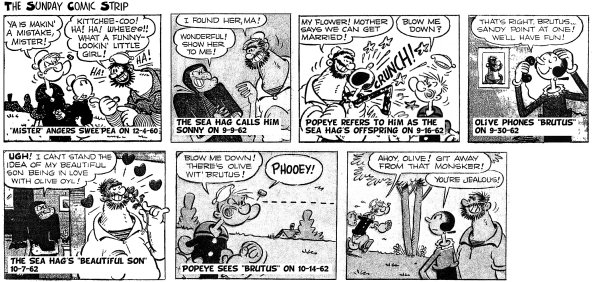
Two pilot animated cartoons were
produced for television to help sell a new Popeye series to stations. One
was Barbecue For Two. This
cartoon, produced by Jack Kinney, was unique as it was the only one using
the comic strip designs of the Popeye cast.
In other words, instead of wearing his white sailor’s uniform,
Popeye was dressed in blue pants, a black shirt with red striped collar
and wearing a captain’s hat. Olive
Oyl had her original homely look as opposed to the more attractive design
featured in many of the theatrical films produced by Famous Studios.
Popeye’s foe in this cartoon was a fat bearded “neighbor”
whom Popeye called “Junior”. The
copyright date of this cartoon was 1960 and it is probable made before Al
Brodax dubbed him, Brutus!
As for products, Bluto was featured
on 1957’s Popeye Cartoon Kit by Colorforms, Popeye Color and Re-Color
Book by Jack Built Toys and Adventures of Popeye Board Game by
Transogram.
Bud Sagendorf provided the artwork for Popeye’s Strength Tester Muscle
Builder by Welded Plastics Corporation. This toy was one of the few times
Sagendorf drew Bluto and called him by that name.
Popeye Printing Set by M. Shimmel Sons Inc. was
copyrighted 1957 but featured a stamp called Mean Man.
Linemar manufactured Popeye and Mean Man Mechanical Fighting Toy.
The “mean man” design used was Bluto in his white sailor’s
uniform from the color theatrical Popeye films.
Linemar also came out with a mechanical Mean Man figure. Samuel
Gabriel Sons and Company included a “Mean Man” barrel in their Popeye
Barrels of Fun set (1958).
By 1960, due to the popularity of the
television cartoons, Brutus was now the name appearing on products. These
included RCA Camden’s Popeye Favorite Stories Album (1960),
Kenner’s
Popeye Presto Paint Set (1961), Popeye View-Master (1962), Jaymar’s
Popeye Funny Face Maker (1962), Popeye and his Pals Game by Ideal (1963)
and Popeye’s TV Cartoon Kit by Colorforms (1966) On the Kenner’s
Give-A-Show projector slides, Popeye initially battled a muscular,
mustached bully followed by Bluto and Brutus.
|
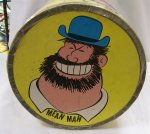
Barrels of Fun |
Throughout
the rest of the 1960’s to 1990’s, with the occasional lapse to Bluto,
Brutus was the name primarily used on Popeye items. The fact Bluto was
used in the 1980 feature film did not slow down the use of Brutus in the
merchandising department. It has only been in the past few years where King Features Syndicate has decided, for the most part, to brand the
bully, Bluto.
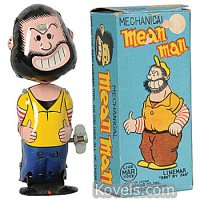 |
 |
|
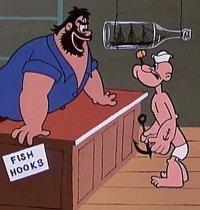
Brutus in the cartoons: Gene Deitch's Sea No
Evil (1960) |
With the many different bearded villains Popeye
encountered over the years: Do they at all vary in character?
Segar had Popeye encounter bearded villains but it was obvious they were not
meant to be Bluto. Bud Sagendorf was primarily responsible for inflicting
Bluto looking bullies against the one-eyed sailor man. They pretty much
were used to serve as Popeye’s punching bag to showcase his strength or
jealousy. The main artistic
changes on each character was the addition of a captain or sailor’s hat,
squinty, plain black eyes or a white circle drawn around each. The noses
were small or bulbous with a curve shape. Their hairstyles and beards were
either unkempt or neat. Whatever
attire these characters wore they highlighted a muscular or fat body
shape. I asked Bobby London, who produced the Popeye daily strip for six
years, what design best suited Brutus - “Brutus is the Gene Deitch (who
produced some of the television cartoons) fat pinhead character with the
black beard. Sagendorf drew Sonny Boy or The Sea Hag’s son who looked
suspiciously like Bluto only in better shape with the same squinty eyes.
Who the fat guy is with the two perpetually blackened eyes that Bud
finally settled on is a mystery to me.”
London is referring to the design of Brutus Sagendorf finally
settles upon by 1967. How
did Brutus become the Sea Hag’s son during the Charlton era? And
these family ties were later abandoned again, right?
It was actually a fan’s correspondence with
Charlton’s Popeye cartoonist, George Wildman, which initiated Brutus
becoming The Sea Hag’s son. Here
is the interview I did with the fan, Donnie Pitchford, who produces the
Lum and Abner comic strip (http://www.lumandabnersociety.org/Comic-Strip-Home.html):
|
|
FG: When did you begin corresponding with George Wildman?
DP: It was immediately after reading The Story of
Popeye in Charlton Popeye
#108, so was early 1971, since his first reply is dated February
22. That story, written by Joe Gill and based on information from
Bud Sagendorf, provided a brief history of the characters.
Although it contained some errors, it was my first glimpse into
the work of Elzie Segar, and I was fascinated. I wanted to know
more.
FG: Did you give George historical information on the
characters? Is this
what led to a correspondence regarding the history of Bluto and
his subsequent monikers?
DP: If I found anything interesting in older issues of the
comics, I shared it with George. Along with his first letter to
me, he included a copy of a letter he had written to an Army
sergeant. The sergeant had asked about the names
"Brutus" and "Bluto," and George asked Bud
Sagendorf for information. The letter was not accurate,
unfortunately, but Bud was presenting information he had been
told. Apparently Bud had not researched the concepts himself at
that time, and was relying on memory.
FG: Do you recall what you wrote which gave George the idea to
have Brutus become the son of The Sea Hag?
|
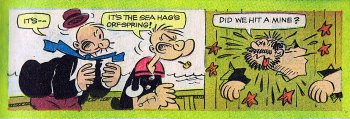
Popeye the
Sailor #66 (1962) |
DP: Yes, sometime in May 1972, I read Gold Key's Popeye the
Sailor #66, cover-dated October 1962. I saw a bearded bully,
and assumed it had to be Brutus. When I saw the references to this
character being the Hag's son, with Popeye referring to him as
“the Sea Hag’s orfspring” and the Hag calling him “Sonny
Boy,” I wrote to George and informed him of this. We must
remember this was in the early 70s, years before much had been
printed, and even more years before a Google search could bring a
mountain of information. Also, that was the oldest issue I owned
at that time. I had no idea about the true legal wrangling’s
involving the change of Bluto to Brutus. When I saw a huge,
bearded villain, I assumed it had to have been Brutus, since that
was the name of the character in the TV cartoons at the time this
comic book came out.
FG: Do you recall
what issue, during the Charlton run, where readers learned Brutus
was The Sea Hag’s son?
|
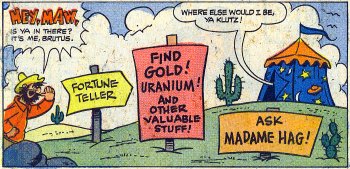
Popeye #128 (1975) |
 |
|
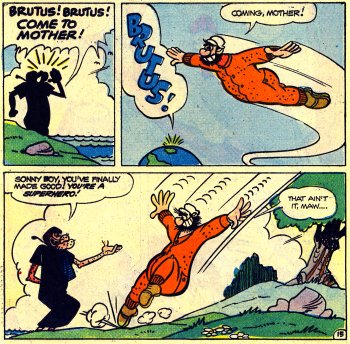
Popeye #137 (1976) |
DP: I have Charlton's Popeye #128, April 1975, in which Brutus calls the Sea Hag “Maw.”
In flipping through Charlton issues prior to that, I don’t see a
reference. Nick Cuti was writing the scripts at that time. Whether
he saw the earlier Sagendorf comics and made the same assumption
or if George shared my notes with him, I do not know. I do know
both Nick and George visited with Bud Sagendorf in the 1970s. Also
in Popeye #130, August
1975, in The Saga of Superstuff, the Sea Hag tells Brutus,
“Throw Popeye to the Sharks, Sonny Boy,” as Brutus asks,
“Now, Mother?” and there are others.
FG: Years later historians had a better understanding of the
evolution of Brutus. Sonny Boy was the Son of the Sea Hag who
looked very much like Bluto. Bud Sagendorf used him in both the
Dell and Gold Key Popeye series.
Sagendorf also featured the brute in both his daily and Sunday
comic strip. When the name Brutus debuted in the comic books in
1962, Sonny Boy vanished. When you discovered the facts what was
your reaction?
DP: I remember assuming the bearded bully was always supposed
to be the same character, regardless of name. I later found more
issues of the comics and noticed neither the name Brutus nor the
name Bluto was being used. I knew there had to be a legal reason.
I remember seeing Gold Key's Popeye the Sailor #67
with Brutus mentioned by name, and had no idea he'd appeared
even earlier, in a Dell-issue, Popeye
#64, April-June 1962. I did not see that issue until a couple
of years ago, as a matter of fact. All of this is confusing, since
Sonny Boy appeared in-between, unless those stories were released
out of order. I never knew if they were all the same character, or
if Bluto, Sonny Boy, and Brutus were actually three different
characters. Years later, Ocean Comics introduced the concept of
Brutus and Bluto being brothers, and more recently Hy Eisman used
this in the Sunday newspaper strip. Even before all that, there
was Burlo, Bluto’s beardless twin brother, when Ralph Stein was
writing the comic strip with art by Bill Zaboly!
Bud Sagendorf's account changed with the years, after he
had researched his own archives.
FG: Whew! Readers need to eat a lot of spinach to keep all
that information straight! Okay, in your opinion, whom do you
prefer, Bluto or Brutus?
|
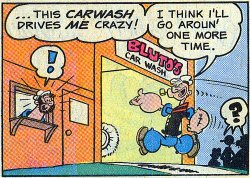
Popeye
the Sailor #148 (1979) |
DP: I prefer the original Segar strips above everything else.
Everything that followed is an adaptation, and that is not meant
to be taken in a negative manner. I just consider the original
Segar material the best, and therefore, I prefer Bluto. I also
prefer the original Max Fleischer animated Bluto to later
incarnations. When both the Hanna-Barbera TV cartoons and the
Robin Williams feature film returned to the name Bluto, I asked
George Wildman if he would follow suit. He replied in a letter of
October 3, 1980, “About Brutus. I like the name, so does Bud and
Bill (writer Bill Pearson). Sorry, Don, but I think I’ll stay
with it. Bud claims it was always “Brutus” in the newspapers
and comics that is one reason I’ve used it since I’ve been
doing the book. To repeat, of the three, Brutus, Bluto and even
Bruno – I like “Brutus!” However “Bluto” actually did
appear in a George Wildman comic book! In Gold Key's Popeye
the Sailor #148, July 1979, in the story “he Myskery of the
Magic Marble, Popeye gets scrubbed (by his own choosing) by
running through “Bluto’s Car Wash!” And there is the big guy
himself, operating the controls! Bluto (or is this Brutus working
for Bluto?) is never called by name, but the name on the car wash
building is shown twice.
|
Donnie Pitchford provided his October 15, 1978 telephone
conversation with long time Popeye artist and writer, Bud Sagendorf,
regarding Bluto & Brutus.
|
|
DP:
Another conflict I’ve wondered about is the Bluto/Brutus
thing. I now know that
Bluto was the original character from the comic strip.
Do you use Brutus In the strips?
BS:
We use Brutus now.
That was a copyright conflict.
When King Features bought back all of the early animated
things, Paramount Studios claimed that they owned the name Bluto.
If King Features
had been a little bit smarter, they would have seen
that Segar used it long before the animation. |
Donnie
Pitchford does not believe Brutus remained related to The Sea Hag after
the Charlton era and I could not find any indication either.
Please do discuss Bobby London's The Return of Bluto
storyline from 1991/92 for a bit!
|

|
Bobby London took over the Popeye daily strip in
1986 with a gag-a-day-format. London
soon began writing storylines putting Popeye and company in a contemporary
setting. He wanted to return
the strip to its Segar roots. On
June 13, 1988 Ham Gravy, Olive Oyl’s original boyfriend, arrived in
Sweethaven, asking about his former flame. Upon his arrival Ham learned
Popeye and Olive had separated. The
first person in town to hear this news from Ham was a familiar looking
bearded brute in the daily strip dated June 16, 1988. On June 20, Olive
working at a seven-eleven, says to this brute, “Sorry, Bluto, but I
won’t go out with you. I left Popeye to find myself, not to date other
guys.” I asked London if
this was his way to return Bluto the strip as he previously used Brutus in
the gag-a-day format. “No, I
drew “The Big Guy” a number of times during the gag-a-day period but
not much and deliberately so. One
strip had him filling out an unemployment form and the clerk says, “Is
Brutus your real name? If not, what is it?” and the Big Guy answers,
“MUD!”” In reference to the
daily strip where Olive uses the name, Bluto, London said, “Olive calls
him “Bluto” when he hears she’s free and comes a-courtin’ in the
7-11. This does not mean
anything, Olive cannot tell a “Brutus” from a Bluto, all men are alike
to her. Clearly, I was testing the waters to see if there would be any
syndicate reaction and there was none.”
Regarding London’s character design for his Bluto he said, “I
had to create my own Bluto based on the Segar version but with touches of
Sonny Boy and whatever Bud settled on last plus my own stylings.”
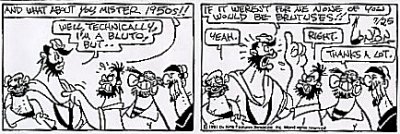 |
On May 27, 1991 London began his The Return of Bluto story which, if you were
a long time Popeye fan, would get all of the ‘in’ jokes and find it
hysterically funny. Even the
casual comic strip reader would find enjoyment. The story concerned
Segar’s original Bluto returning to Sweethaven to, as he put, “I,
Bluto the Terrible was once the most feared man on the seven seas… one
lost battle with Popeye and Sweethaven was full o’ goofy-lookin’
clowns imitatin’
me…yeah… ruined my reputation. I mean how could anybody be scared of a
guy named “Brutus”!” The Sea Hag, with her laptop computer, leaves a
message on the community billboard, in Popeye’s name, to every guy in
town named Brutus. All of the Brutuses gathered together, each being a
version Popeye has previously encountered in different media.
These included Bud Sagendorf’s perpetually blackened eye design,
Gene Deitch’s version from the television cartoons, one wearing a pirate
costume and two different designs of the bully from Italy.
Additionally London featured the variations of Bluto: Ralph Stein
and Bill Zaboly’s interpretation, as he appeared in Hanna-Barbera’s
All New Popeye Hour and Popeye and Son animated cartoons, plus, one of the
most familiar, wearing a sailor’s uniform from the Famous Studios
theatrical productions. In
addition Mean Man and Sonny Boy appeared along with a pint-sized,
“90’s Brutus” and the “Martian Brutus” (originally the Martian
menace in the 1946 Popeye theatrical cartoon, Rocket to Mars).
London said, regarding coming up with this story idea, “I treated the
strip as if it belonged to E.C. Segar so it was only natural to bring the
real Bluto back and try to set things right.”
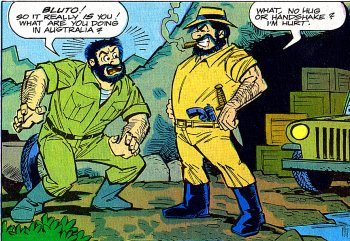 |
How did the idea that Bluto and Brutus were brothers get started,
and its significance for the Popeye continuity?
I believe the idea of Bluto and Brutus being
brothers began with the publication of Popeye #2 (1988) published by
Ocean Comics. This mini-series
featured the characters with a more illustrative look rather than a
cartoony one. The story
celebrated the 200th anniversary of Australia as a nation and
was called Double Trouble Down Under.
Popeye and Brutus discover Bluto is making trouble in Australia
with an angry Kangaroo. I
asked Ron Fortier, who wrote the story, whose idea was it to make Bluto
Brutus’ twin brother and he replied: “Mine, I thought it was high time
someone addressed that mix up in a story.
Which was it? I thought why not have both and they are twins.
It worked super well for the story.
Those Popeye fans really loved it and thought it was an ingenious
solution to the problem.” I asked Fortier, in his mind, who should
Popeye be fighting - “My first introduction to Popeye was in the
Fleischer cartoons and in those he battled Bluto.
So if I had to pick one it would have been Bluto.”
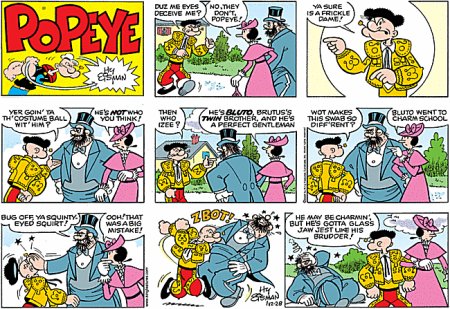
Hy Eisman, December 28, 2008 |
I contacted Hy Eisman and explained Bluto had never appeared in a Popeye
Sunday comic strip. Eisman has been producing the Sunday page since 1994
and on December 28, 2008 Bluto made his debut. As in the Ocean Comics
story he was introduced as the twin brother of Brutus. In the Sunday comic
dated April 5, 2009 The Sea Hag recruited both Brutus and Bluto in her
attempt to defeat Popeye.
|
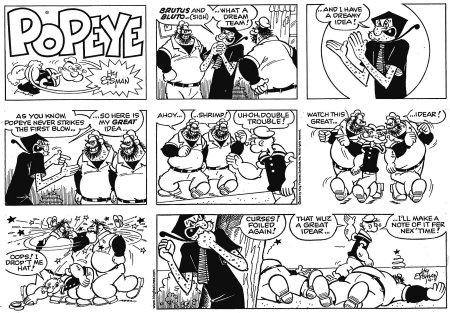
Hy Eisman, April 5, 2009 |
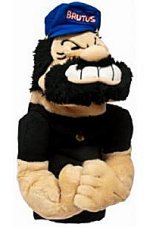
Winning Edge golf cover |
Today, is it Bluto or Brutus?
|
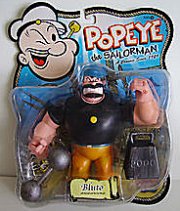
Mezco character figure |
In the new Sunday page by Hy Eisman it is still
Brutus (the daily strip currently consists of Sagendorf reprints).
While IDW was producing a new Popeye comic book it was Bluto.
The name flip-flops on merchandise. Beginning in 2001 Mezco
released several Popeye character figures and used Bluto’s visual design
from theatrical films by both the Fleischer and Famous Studios. Several
products have used the Fleischer Studios version of Bluto calling him
Brutus. An example of this was a golf cover by Winning Edge.
If
you go to the Popeye character page at the King Features Syndicate
website (http://kingfeatures.com/comics/comics-a-z/?id=Popeye) they use a Hy
Eisman drawing of Brutus called Bluto.
|
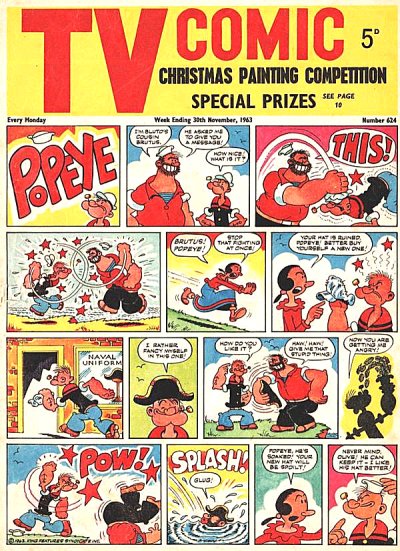
TV Comic 624 (1963) |
After all these years I would love to say things are
less confusing as to who is who, but not quite yet.
How did you gather all these facts, actually?
A lot of the facts were discovered by reading the comic
strip and books. Admittedly I
was not necessarily looking for information regarding Popeye’s bearded
opponent but stumbled upon it. I would like to take this opportunity to
thank people who have contributed to this article: Debbie Brooks, Ron
Fortier, Dave Hudon, Bobby London, Mile High Comics and Donnie Pitchford.
Sonny Boy and Brutus stories worth reading, from
whatever era?
I would definitely check out Bobby London’s The
Return of Bluto story which The Official Popeye Fan Club has archived.
Please go to www.popeyethesailor.com/club/.
Anything else you are dying to mention and I have merely
forgotten to ask?
The name changes surrounding the brute were not limited
to the United States. For
example, Popeye Annuals were published in London for several years. While
the name Bluto was originally used in these publications he was also known
as The Big Man and later, Brutus. TV Comic 624 (November 30, 1963) had a
bearded man, wearing a sailor’s hat; introduce himself to Popeye saying
“I’m Bluto’s cousin Brutus.” Cousins?
I can hear the theme song to The Patty Duke Show playing during
this meeting. Thanks for the interview! And
so you can all leave with a chuckle, here's Sonny Boy's first appearance
in Popeye # 43 (1958) 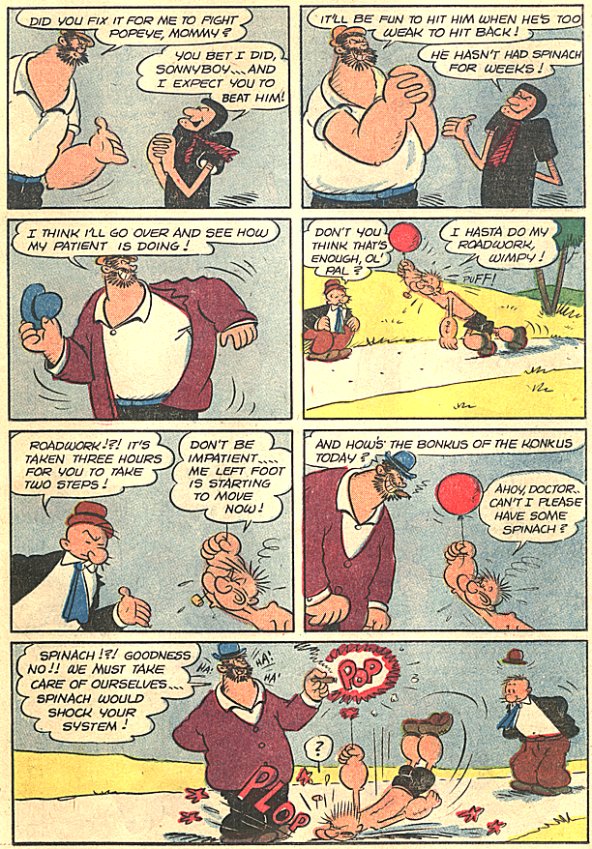
|